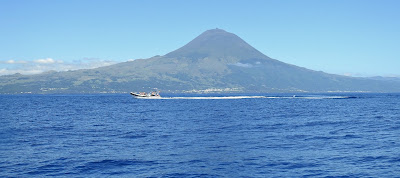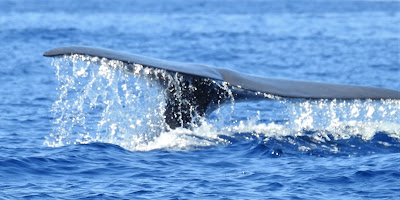The name Azores comes from the Portuguese açor, meaning goshawk - and a golden goshawk is on their flag. The first explorers, who named the island, mistakenly took the local sub-species of the common buzzard to be a goshawk.
We landed on the largest island, Sao Miguel, in the eastern group.
A 3D model at the airport introduced the volcanic terrain we would see.
I sketched a typical view of the island - a building of black volcanic stone surrounded by creeping blue morning glory.
I drove to the highlands in east of the island, where there are still tracts of laurisilva forest.
In the forest is the Centro Ambiental do Priolo. They are have a programme to re-establish laurisilva vegetation.
The laurisilva is home to the Azores Bullfinch (Pyrrhula murina) - known locally as Priolo - first described by the English naturalist Frederick DuCane Goodman in 1866. It is one of the two endemic bird species of the Azores (the other being a storm-petrel) - and is only found in these forests on Sao Miguel. Unlike the European Bullfinch, the males and females are identical - both taking the duller female form. It is classified by BirdLife as an endangered species, but conservation efforts have increased its numbers to near 1,000 from less than 100 in the 1970s. Unusually, it is known to feed on ferns in the winter when food is limited.
From the high point of the forest I looked back into the agricultural interior of the island.
Around me I saw the efforts to re-establish the laurisilva. Japanese Cedars, grown for timber, are being killed - and in the grey slopes that remain endemic plants are being planted which provide berries for the bullfinches (which in turn disperse the seeds).
Vaccinium cylindraceum was first described by English botanist James Edward Smith in 1817. It is pollinated by moths.
Juniperus brevifolia has become vulnerable due to being cut for its wood.
The humidity of the forests allows the formation of carpets of moss, which hold water like sponges.
I was lucky enough to see a pair of bullfinches working their way along the herbs at the side of a path, nibbling at the flowers and seeds.
Overhead flew the Azores (and Canary islands) sub-species of common buzzard (Buteo buteo insularum) - the misidentified açor of the early explorers. It is a richer brown above than the mainland buzzard.
To the west of the forest lies Furnas, a place where the heat of the depths of the earth comes to the surface.
From our accommodation we could watch the steam rise...
...and in the evenings take some boiling water with which to make tea.
Around the garden starlings flocked. It is the Azores sub-species, Sturnus vulgaris granti - smaller than those on the mainland.
There is a park in the town where one can bath in a ferric orange hot spring. In the plant beds the Azores sub-species of blackbird (Turdus merula azorensis) hunt for worms.
As in the Canary Islands, the local robins were very tame...
...with many fledged young hopping about.
Only six species of butterflies have been recorded from the Azores, and only one - the Azores Grayling - is endemic. I found one of the others: the Long-tailed Blue (Lampides boeticus).On one of the ponds, one of the six species of dragonflies and damselflies found on the Azores: a female Blue Emperor (Anax imperator).
The stillness of Lake Furnas contrasted with the bubbling springs.
Around its edge Goldcrests continually move. They are believed to have colonized the Azores during the Pleistocene, 100,000 years ago, and diverged among the islands. This is the sub-species endemic to Sao Miguel, Regulus regulus azoricus. There is another sub-species on nearby Santa Maria (sanctiemariae), and one on the central and western island groups (inermis).
In the centre of Sao Miguel the caldera lake Fogo.
In the car park on the rim a Grey Wagtail (Motacilla cinerea) of the Azores sub-species patriciae.
On the shore, one of the 19 sub-species of Chaffinch (Fringilla coelebs) found in the Palaearctic - a male of the Azores moreletti. He has deep slate-blue upper parts, as in the Canary Islands sub-species, but in addition a bright green mantle.
There was also a colony of Yellow-legged Gulls (Larus michahellis) of the Macaronesian sub-species atlantis.
In the west of the island, the famous calderas of Cidades.
No endemics seen here - just old friends: a Common Tern (Sterna hirundo)...
...a Little Egret (Egretta garzetta) among the Mallards...
...and one of my favourites, the House Sparrow (Passer domesticus).
Continuing to the end of the island we bathed in a basalt rock pool at Ponta da Ferraria, where hot spring waters met the cold surf of the sea.
We caught a flight to the central island group - to Pico.
The island is dominated by the Montanha do Pico volcano at its centre.
We had a fine view from the youth hostel.
Over the hostel bats flew.
I found them returning to a nest in a wall by the car park.
They are Azores Noctules (Nyctalus azoreum), the only endemic mammal to the Azores. It diverged recently from the mainland Lesser Noctule, and has darker fur and a 4-5 Hz higher echolocation call. It is the only species of bat in the world that hunts by day - believed to be an adaption to there being no avian predators.
A Collared Dove (Streptopelia decaocto) perched nearby.
Driving through the fields inland we saw large flocks of Canaries (Serinus canaria). I heard two Quails (Coturnix coturnix) calling from the field next to me - they would be of the Azores sub-species conturbans - but of course they wouldn't show.
In the rocks we saw the only lizard found in the Azores (apart from a gecko), the Madeiran wall lizard (Teira dugesii). It is actually endemic to Madeira, but has been accidentally introduced by the shipping trade.
There are plenty of rockpools on the island for evening bathing.
In them we saw plenty of Marbled Rock Crabs (Pachygrapsus marmoratus), which scuttled away when we walked near...
...and Rock-pool Blennys (Parablennius parvicornus).
We ate the Rough Azorean Limpet (Patella candei) cooked in garlic. Delicious. I subsequently found out that this Macaronesian endemic is under threat from human consumption. Whoops.On the coastline grows Azorina vidalii, an endangered Azores endemic with less than 1000 mature plants, first collected by the English botanist Hewett Cottrell Watson in 1843. It is believed to have diverged from its ancestral descendants around eight million years ago.
Signs by the roadside showed the locals are actively hunting introduced pests...
...but they'll never find me!
We took the ferry over to Faial island, a short distance across the water from Pico.
I found a small reserve north of Horta, the Jardim Botanico Pedro Miguel - an area of Azores Heather (Erica azorica).
In the street outside an obliging Wood Pigeon stood. I assume it is the Azores sub-species, Columba palumbus azorica.
In the centre of the island is a complex of calderas, the peak of which is the Cabeço Gordo - 2,000 metres across and 400 metres deep.
A reminder that volcanic activity is ongoing: in 1957 the Capelinhos volcano on the west of the island erupted, creating a new area of land beyond the lighthouse. The agricultural land became unusable, and 4,000 islanders emigrated to the USA.
We took a whale-spotting trip from the port of Horta.
We passed rafts of Cory's Shearwaters (Calonectris borealis).
A Portuguese man o' war (Physalia physalis) drifted past. It is not a true jellyfish, but a siphonophore - a colonial organism made up of many specialized animals of the same species called polyps. The polyps are attached to one another and cannot survive independently, each working together to function like an individual animal. On the beaches of Sao Miguel we saw the lifeguards blow their whistles and pull them out of the water.
We also saw what we came to see: Sperm Whales (Physeter macrocephalus) - in fact we saw a dozen, including a mother with her child. Whaling was banned in the Azores in 1985, and the old 'look-outs' in their perches on shore are now used for the tourist industry. There are now around 1,000 Sperm Whales living around the islands. They feed almost exclusively on squid, and can dive down over two kilometres to feed using echolocation. They come back to the surface for about ten minutes to breath and replenish their muscles with oxygen. They have the largest brain of any living or extinct animal - five times heavier than the human brain.
I managed to take a series of photos of a tail (or fluke) turning as a whale prepared to dive.
More impressive, I managed to steady myself in the boat enough to take a short film.

















































































No comments:
Post a Comment